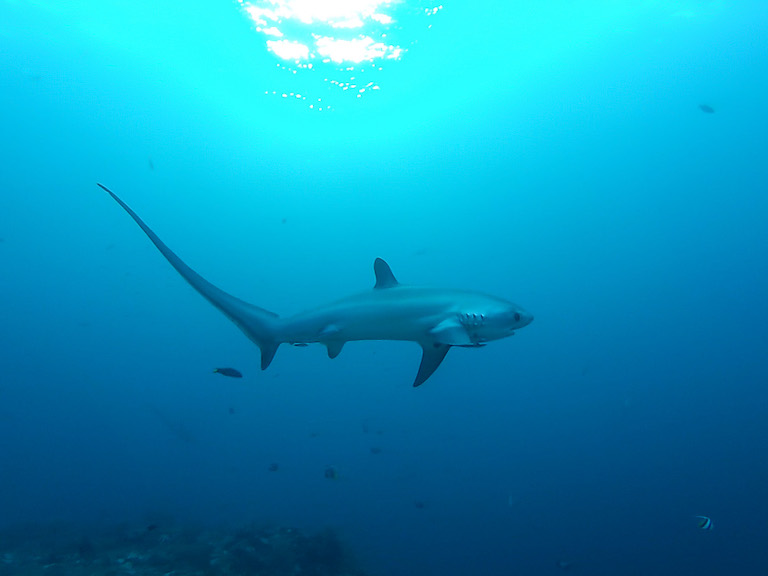- The Shark Fin Sales Elimination Act of 2017, introduced before Congress on March 9, would terminate the possession and trade of shark fins in all 50 U.S. states and 16 territories.
- Activists and advocacy groups often cheer these bans as a way to protect sharks. Internationally about 70 of the planet’s 400-plus shark species now face extinction, often due to overfishing..
- However, some experts argue that better tracking to determine whether imported fins were caught sustainably, followed by trade restrictions on those that weren’t, represent the best steps toward saving threatened shark species.
- Some go so far as to argue that a U.S. trade ban may do more harm than good, by crushing a domestic industry that exports sustainably caught fins to markets in Asia and allowing less-sustainable fisheries to take up the slack.
Dave Ebert pulls up an image on his computer screen. The object in the picture is shaped like an oversize arrowhead, thin, yellowish, and fraying at its edges. It’s a dried shark fin, the key ingredient in the Chinese delicacy shark fin soup. Border officials confiscated it from someone entering the U.S.
The U.S. Fish and Wildlife Service (FWS) Office of Law Enforcement in Burlingame, California, sent the image to Ebert to identify exactly what species of shark the fin came from. If Ebert determines that it belonged to a species listed under the Convention on International Trade in Endangered Species of Wild Fauna and Flora (CITES), an agreement to ensure that international trade of certain species doesn’t threaten their survival, the FWS will consider law enforcement action against the fin’s owner.
Ebert heads the Pacific Shark Research Center at Moss Landing Marine Laboratories in Moss Landing, California. Many of the fins he identifies for law enforcement officials belong to species that are threatened with extinction and illegal to trade under CITES. Ebert has visited South African villages where people desperate to make a living sell fins to buyers from Hong Kong. And he’s seen fins pop up in Sri Lankan markets from shark species that were unknown to science.
“It’s maddening to see something show up in the fish market,” Ebert told Mongabay. “We’re like ‘Holy! We don’t even know what this thing is!’”

Ebert knows how hard it is to police this international trade, in hopes that fins that end up in restaurant kitchens have been sustainably fished. Yet he and many other shark conservation experts are skeptical about a bill before Congress, called the Shark Fin Sales Elimination Act of 2017. Congressmen Ed Royce (a Republican from California) and Gregorio Kilili Camacho Sablan (an Independent from the Northern Mariana Islands) introduced the bill on March 9.
“There’s a lot more concern and consciousness here,” Ebert said of the U.S. “In the U.S., we’re actually pretty good at enforcing laws in terms of finning, whereas in the rest of the world not so much.” He believes that the elimination of the U.S. fin market would have little effect on shark conservation worldwide. The U.S. exports an average of 171 metric tons of fins valued at $3.4 million annually — just 1 percent of the global volume of fins traded — according to the National Marine Fisheries Service (NMFS), a division of the National Oceanic and Atmospheric Administration (NOAA).
If the Shark Fin Sales Elimination Act passes, it would terminate the possession and trade of shark fins in all 50 U.S. states and 16 territories. Already 11 states, including California, and three territories have bans in place.
Activists and advocacy groups often cheer these bans. However, many experts say that they are not the best way to help overfished shark populations recover or to stop finning-at-sea, a practice where fishers cut off a shark’s fins and throw the rest of its body overboard, often still alive but doomed. Instead, experts argue that better tracking to determine whether fins come from a stable population and whether the sharks were finned or caught whole, followed by trade restrictions on unsustainably caught fins, represent the best steps toward saving threatened shark species. Some go so far as to argue that a U.S. trade ban may do more harm than good, by crushing a domestic industry that exports sustainably caught fins to markets in Asia and allowing less-sustainable fisheries to take up the slack.
In February 2016, the journal Conservation Biology published a study reporting survey responses from 102 shark researchers, mainly from the U.S., Australia, and Canada. The survey asked whether the researchers supported a range of 11 different international policies, including fishing quotas, bans on finning-at-sea, listing species on CITES, and banning the trade in shark fins. Banning the fin trade, though supported by about 60 percent of the researchers, was the second least-popular option. By contrast, more than 90 percent backed the idea of sustainable fishing using strict catch quotas, the most popular choice.
“Full utilization of sharks taken in sustainable fisheries would logically require that some of the fins get used,” one of the scientists wrote in the survey. Another added: “A nationwide ban on shark fishing is unwarranted. There are populations that are capable of supporting a sustainable fishery.”
U.S. shark fisheries are already heavily regulated to protect species that, as top predators, are vital to the health of marine ecosystems. In 1993, the federal government started limiting the species and number of sharks caught. Since then, regulations have become more stringent. In 2000, officials banned shark finning in U.S. waters due to ethical and environmental concerns. Sharks are typically slow to mature and produce few offspring, making it hard to know whether the regulations have helped. However, recently some coastal shark populations have shown signs of recovery. A study published in the journal Fish and Fisheries in February found that most formerly over-exploited shark species along the U.S. east coast and in the Gulf of Mexico were on the rise, following the implementation of careful management in the 1990s.

Banning the fin trade
Still, about 70 of the planet’s 400-plus shark species — including those targeted for their fins — now face extinction. In the U.S., fins bought and sold at ports also come from international fisheries, which may lack protections to prevent finning-at-sea or overfishing. Advocates cite this as a reason for a total ban on the shark fin trade.
“The best way to get out of that situation is just to end the fin trade entirely,” Mariah Pfleger, a marine scientist with the conservation nonprofit Oceana, told Mongabay. In June 2016, Oceana backed a bill similar to the current one. It didn’t pass. This year, Oceana is rallying the public to push for The Shark Fin Sales Elimination Act. The nonprofit argues that current regulations are insufficient.
Former Democratic California State Assembly member Paul Fong feels the same way. He co-sponsored the bill that initiated the statewide ban in California in 2013. At the time, 78 percent of the state’s citizens, including 70 percent of the Chinese population, supported Fong’s bill.
Fong is deeply bothered that, despite California’s ban, about 60 tons of fins — more than 90 percent of the total entering the country, Oceana estimates — still enter the Port of Los Angeles annually, destined for states where no ban is in place. He argues that efforts by NOAA and the Food and Agricultural Organization of the United Nations (FAO) to track the import and export of shark fins and to determine whether fins come from countries with sustainable shark management are not enough.
“It’s too difficult to track. It’s impossible, actually. You have to do DNA samples on the shark fins, too, and it’s too expensive to make that possible,” Fong told Mongabay. “You want to save the ones that are endangered, of course. But they all become endangered eventually.”
The two agencies currently don’t even seem to agree on how many shark fins are entering and leaving the U.S. each year. In a 2015 technical paper, the FAO compared its own import and export statistics with NOAA’s and found some inconsistencies. Notably, when the FAO added up shark fin exports declared by other countries as destined for the U.S., exports were seven times greater than the imports reported by U.S. officials. Oceana, in its 2016 report Shark Fin Trade: Why it Should Be Banned in the United States, used this discrepancy to argue that U.S. shark fin imports and exports are “much greater” than NOAA reports, and that this exacerbates the need for a fin ban.
The root of some reporting discrepancies is inconsistent labeling of shark products, according to Lindsay Davidson, a doctoral candidate in marine biology who focuses on the sustainability of shark fisheries at Simon Fraser University in Burnaby, British Columbia. A package labeled “sharks” might contain fins, meat, or oil, she wrote in an email. “The current system does not allow for accurate tracking of fin, meat, or other product trade between countries.”
Rickey Tome, a wildlife inspector with FWS’s Burlingame Office of Law Enforcement, agrees. He pointed out that fins from rays and skates, both close cousins to sharks, are also labeled “shark fins.”
That leads some biologists to think that a trade ban might be necessary, at least as a temporary fix. “It’s not a solution, but it might be a Band-Aid,” said Neil Hammerschlag, a marine ecologist and director of the Shark Research and Conservation Program at the University of Miami, who co-authored the survey of shark experts. A nationwide ban might give vulnerable populations of sharks time to recover while sustainable fishing practices could be implemented abroad, ultimately rendering the ban unnecessary, he said.

Improving tracking
Many shark biologists do not support a trade ban, however. They argue that NOAA could do much more to control the import of unsustainably harvested fins if it acted on existing regulations.
NOAA is required to certify whether nations are compliant with standards set in the Shark Conservation Act of 2010, for instance by prohibiting finning-at-sea in international waters. With presidential approval, federal officials can restrict imports from countries listed as noncompliant. (It’s debatable how likely that would be under President Trump, whose administration recently reversed a ruling intended to prevent the overfishing of flounder on the U.S. east coast.) However, in its 2015 and 2017 biennial reports, NMFS declined to identify any nation as noncompliant, citing a lack of data on shark catches.
“Basically their system certified almost every nation as compliant. We all know that’s a joke,” said Robert Hueter, director of the Center for Shark Research at the Mote Marine Laboratory in Sarasota, Florida, and a member of NMFS’s Advisory Panel for Highly Migratory Species. If NOAA got “serious,” Hueter said, the U.S. could reduce its import of illegal and unsustainable fins.
Hueter opposes a nationwide ban on the possession and trade of fins. In an April letter to Florida’s Republican congressman Carlos Curbelo, who co-sponsored the Shark Fin Sales Elimination Act (also called H.R. 1456), Hueter argued the bill would unfairly punish American commercial fishermen. In abiding by strict shark fishing regulations, these fishers hunt sharks not just for their fins but also for their meat, skin, liver oil, and cartilage. “H.R. 1456 is not about ending finning, but instead will cause the demise of a legal domestic industry that is showing the rest of the world how to utilize sharks in a responsible, sustainable way,” Hueter wrote.
According to Russell “Rusty” Hudson, a consultant whose Daytona Beach, Florida-based company, Directed Sustainable Fisheries, Inc., represents most American shark fishermen, the bill would force his clients to throw fins, the source of about half their profits, overboard.
“The ecosystem is important and must be protected, though we can sustainably harvest needed food sources for human beings also,” Hudson wrote in an email. “We should have the privilege to exist as an accountable, sustainable fishery, and not be put out of business by a misinformation campaign.”
Banning the U.S. trade in shark fins could also unintentionally increase finning-at-sea and unsustainable catches overseas, Hueter said. By taking U.S-caught shark fins off the international market, H.R. 1456 would increase the market for countries not practicing legal and sustainable shark fishing, he contended. “It will therefore punish the good people — American fishermen — and reward the bad people, the foreign fleets practicing finning and illegal, unreported and/or unsustainable fishing.”

Davidson agrees. The U.S. is a global source for sustainably caught fins, albeit just 1 percent of the total volume traded. Advocacy groups and politicians are “well-intentioned,” she said, but there are more options than a blanket ban. “There is a general idea that bans are the only conservation tool for a fished species. However, there are many global examples of sharks being fished sustainably.”
In California, Ebert sees an example close to home. On the West Coast, a species called the thresher shark (Alopias vulpinus) is thriving, he said, thanks to decades of well-managed fishing practices like catch limits, which allow a fisherman to catch only two per day.
“If guys can make a little money on the fins rather than discarding them,” Ebert said, “then why not?”
The House Committee on Natural Resources is currently considering the bill, its fate uncertain. But whether it passes or fails, the urgency to protect sharks makes it likely that the debate about bans will continue.

Citations
Dent, F., & Clarke, S. (2015). State of the global market for shark products. FAO Fisheries and Aquaculture Technical Paper, 590.
Peterson, C.D., Belcher, C.N., Bethea, D.M., Driggers, W.B., Frazier, B.S., & Latour, R.J. (2017). Preliminary recovery of coastal sharks in the south‐east United States. Fish and Fisheries 00:1–15.
Shiffman, D.S. & Hammerschlag, N. (2016). Preferred conservation policies of shark researchers. Conservation Biology 30: 805–815.

| Editor’s note 7/25/17: The original title of this story has been modified. Also, the original version of this story incorrectly listed the countries where shark researchers surveyed for a Conservation Biology paper were based. |
FEEDBACK: Use this form to send a message to the editor of this post. If you want to post a public comment, you can do that at the bottom of the page.